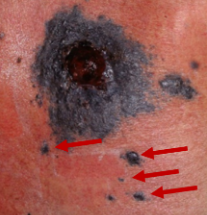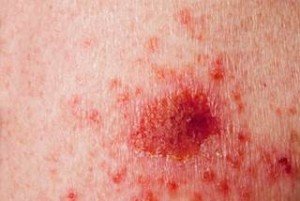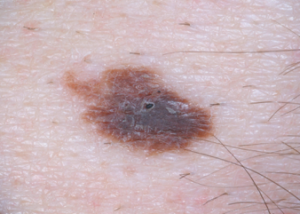You’ve read that “satellite” spots around a mole is a sign suspicious for melanoma.
But is it possible for satellites to just be a normal feature of a mole?
In checklists for signs that can mean melanoma, “satellite moles” is sometimes on the list.
This feature doesn’t get as much attention as other warning signs such as crusting, bleeding, an increase in size, changes in shape and changes in color.
“Satellites, or satellites nevi, are smaller pigmented lesions near a giant pigmented mole or melanoma,” says Alpana Mohta, MD, DNB, a dual board certified dermatologist who specializes in clinical and aesthetic dermatology.
Nevi (rhymes with Levi) is the medical term for moles. The singular is nevus.
Dr. Mohta explains that satellites around a mole “are often an indicator of the spread or potential spread of atypical melanocytes beyond the primary lesion. A mole with satellites is not considered normal in dermatology.”
A melanocyte is a pigment producing cell. When this type of cell is atypical, this means it’s at higher risk of eventually becoming malignant, but it’s not a guarantee.
“Concerning melanoma, microsatellite tumors or satellite tumors indicate stage III melanoma spread.
“It signifies the potential for the primary mole or melanoma to have invaded nearby tissues or spread to regional lymph nodes or distant sites.
“Satellites typically indicate a more advanced stage of melanoma or a higher likelihood of metastasis.
“However, all cases of satellite nevi or moles are not melanoma.
“At times, patients with congenital melanocytic nevus might also develop satellite nevi.”
What exactly is satellite nevi?
When we hear of satellite moles, we think of common looking dots around a larger dot, the primary mole.
Perhaps you’re picturing a medium brown mole with medium brown little dots around it like planets around a star.
Within the terminology relating to malignancy, a satellite is a skin cancer that has broken off from the primary melanoma via the lymphatic system and is within 2 cm of the primary tumor.
Though this visible presentation is highly suggestive of melanoma, only a microscopic analysis through a biopsy can confirm disease or a benign situation.
There’s actually a benign condition called blue nevus satellitosis. But this diagnosis can only be made after a microscopic analysis of the biopsied tissue.
A blue nevus satellitosis is EXTREMELY, EXTREMELY RARE.
So if you have “little moles growing around a bigger one,” it’s almost guaranteed it’s not a harmless blue nevus satellitosis.
If you notice what appear to be new tiny spots, dots or nodules near a mole, this needs to be seen immediately by a dermatologist.
The satellites in a melanoma won’t always be the same color as the original lesion.
The satellites may even appear to be more like little blemishes or small flesh colored bumps than bits of the original “mole.”
There may be two or three satellites. Or, there may be a peppering of them.

Satellites from a melanoma are also known as transit metastases.
Have the satellites always been there?
The suspicion for melanoma is high if the satellites are newly appearing around a mole that has always been there – especially if the main mole has undergone some visible changes lately.
The area needs to be biopsied promptly – even if you kind of think that the tiny little spots that orbit the main mole may have “always been there.”
It’s also not likely or typical for a benign mole to sprout satellites as it forms during childhood – when most moles are acquired.
Now certainly, by coincidence during childhood, a typical mole may happen to have a few smaller moles independently develop nearby.
And there is no progression; this is just how one’s common moles have developed.
The bright red flag is when there’s reason to believe that the tiny spots or bumps popping up around a mole are NEW — especially when the main mole is also new!

The satellites of this melanoma are many.
Yes, it’s an alarming situation if the main mole itself is new and undergoing visible changes over a relatively short period of time.
If you have new spots or tiny lumps around a mole, even if the mole looks completely normal or unchanged, have a dermatologist examine the area. You will probably be advised to have a biopsy.
If you’re told that it’s “just a fungus,” immediately seek a second opinion.
If any doctor tells you it’s nothing concerning, after all they did was view some images you sent them — immediately seek a second opinion: IN PERSON.
In the world of dermatology, looks can be incredibly deceiving.
The human eye is a very poor screening tool for melanoma. And in fact, even under the lighted lens of a handheld dermatoscope, a melanoma can pass as “nothing to worry about.”
GET A BIOPSY.
Dr. Alpana explains five things you should know about melanoma.
 Dr. Alpana Mohta is a dual board certified dermatologist and owner of dralpana.com. Her areas of interest include clinical dermatology, dermatopathology and dermatosurgery. She has over 85 research publications in numerous journals. Apart from her regular medical practice, she is also a medical writer, reviewer and advisor for many companies.
Dr. Alpana Mohta is a dual board certified dermatologist and owner of dralpana.com. Her areas of interest include clinical dermatology, dermatopathology and dermatosurgery. She has over 85 research publications in numerous journals. Apart from her regular medical practice, she is also a medical writer, reviewer and advisor for many companies.
 Lorra Garrick has been covering medical, fitness and cybersecurity topics for many years, having written thousands of articles for print magazines and websites, including as a ghostwriter. She’s also a former ACE-certified personal trainer.
Lorra Garrick has been covering medical, fitness and cybersecurity topics for many years, having written thousands of articles for print magazines and websites, including as a ghostwriter. She’s also a former ACE-certified personal trainer.
.










































